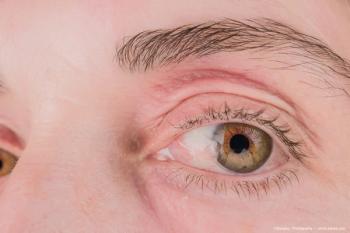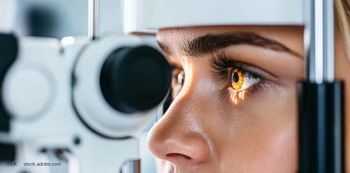
Effect of vaping on the eyes
Editor’s Note: Welcome to “
The headlines are disturbing: Vaping has been linked to deaths, as well as lung transplants for otherwise healthy teens.
What’s going on? What are the implications for the eyes?
We know that exposure to any smoke can inflame the ocular surface, but what about vapor from vaping? Can vaping affect other parts of the eyes as well?
I found some unsettling answers.
Previously by Dr. Periman:
High nicotine levels are common.
Unlike cigarettes, which contain the amount of nicotine that naturally occurs in tobacco, vaping fluid contains extracted nicotine in levels that are uncontrolled and often unknown.
Doctors are seeing nicotine-induced illness (“nic-sick”), particularly in teens.1 This includes seizures, anxiety, depression, cognitive compromise, and inattention.
Pictured: A 36-year old ocular surface disease (OSD) meibomian gland dysfunction (MGD) patient who frequently uses vaped THC.
Photo credit: Laura M Periman MD
Effects of nicotine on the eye include pupil constriction2 and reduced retinal activity visible on electroretinogram (ERG).3
Related:
Vaping fluid is packed with other chemicals.
In addition to nicotine, vaping fluid components include acrolein (2-propenal), an aldehyde that severely limits regulatory t-cells - a mechanism that can thereby activate and contribute to chronic dry eye disease (DED).4
Carriers and flavor additives can also cause lung toxicity and directly activate the transit receptor potential (TRP) of the ocular surface immune system and corneal nerves.5
Some vaping chemicals may also activate the immune mechanism of chronic
Related: New for 2020 and beyond: Dry eye disease agents in pipeline
Ingredients are largely unregulated.
The rash of cases where vapers experienced severe lung toxicity requiring lung transplants occurred after a change in manufacturing resulted in the addition of vitamin E to some vaping cartridges.7
A retrospective analysis of the vaping fluid composition showed that 100% of the cartridges used by the affected patients contained vitamin E, which had not been present in the same cartridge brand in the past. The sticky ester was used as a filler, but it is not safe for inhalation.
Related:
Without regulation, it is impossible to know if or when other potentially dangerous substances will be added to vaping fluid in the future. The reputation of the brand does not confer pulmonary or other organ system safety to our patients.
Researchers are now studying OSD and vaping.
One recent paper looked at ocular surface findings in vapers versus non-vapers and found that vapers had staining and compromised tear breakup time.8
Schirmer’s tests were inconsistent in the vaping group, and may be attributed to compensatory lacrimal gland output phases of dry eye disease, which can burn out over time.
Related:
What should we do?
After reading more about the chemicals involved in vaping and their effects, I believed more than ever that treatment for
Particularly, if they are exposed to chemicals that may affect the inflammatory cycle, then treatments that reduce inflammation-such as omega-3 fatty acids (HydroEye, ScienceBased Health), cyclosporine (Restasis, Allergan; Cequa, Sun), lifitegrast (Xiidra, Novartis), intense pulsed light therapy (Optima IPL, Lumenis) and thermal in-office modalities (TearCare, Sight Sciences; iLux, Alcon; and LipiFlow, Johnson & Johnson Vision)-may be offered to help tip the scales in the positive direction.
Related:
Most importantly, I’ve added vaping to my practice’s Dry Eye Services intake form. I want to know if patients vape, as well as if they’re routinely exposed to vaping secondhand.
My patients need to understand the risks they’re taking for their eyes and their overall health. Physician efforts to educate patients often result in improved patient health.
About the author
Laura M. Periman, MD
E: [email protected]
Dr. Periman is an ocular surface disease expert and director of Dry Eye Services and Clinical Research in Seattle, Washington.
Newsletter
Don’t miss out—get Ophthalmology Times updates on the latest clinical advancements and expert interviews, straight to your inbox.













































.png)


